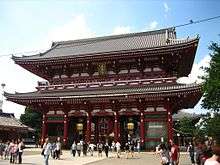Sensō-ji
| Sensō-ji 浅草寺 | |
|---|---|
 | |
| Basic information | |
| Location | 2-3-1 Asakusa, Taitō-ku, Tokyo |
| Affiliation | Shō-Kannon (independent school) |
| Deity |
Shō Kannon Bosatsu (Āryāvalokiteśvara) |
| Country | Japan |
| Website | http://www.senso-ji.jp/ |
| Architectural description | |
| Founder | Kaishō |
| Completed | 628 |
Sensō-ji (金龍山浅草寺 Kinryū-zan Sensō-ji) is an ancient Buddhist temple located in Asakusa, Tokyo, Japan. It is Tokyo's oldest temple, and one of its most significant. Formerly associated with the Tendai sect of Buddhism, it became independent after World War II. Adjacent to the temple is a Shinto shrine, the Asakusa Shrine.[1]
History
The temple is dedicated to the bodhisattva Kannon (Avalokiteśvara). According to legend, a statue of the Kannon was found in the Sumida River in 628 by two fishermen, the brothers Hinokuma Hamanari and Hinokuma Takenari. The chief of their village, Hajino Nakamoto, recognized the sanctity of the statue and enshrined it by remodeling his own house into a small temple in Asakusa so that the villagers could worship Kannon.[2]
The first temple was founded in 645 AD, which makes it the oldest temple in Tokyo.[3] In the early years of the Tokugawa shogunate, Tokugawa Ieyasu designated Sensō-ji as tutelary temple of the Tokugawa clan.[4]
The Nishinomiya Inari shrine is located within the precincts of Sensō-ji and a torii identifies the entry into the hallowed ground of the shrine. A bronze plaque on the gateway structure lists those who contributed to the construction of the torii, which was erected in 1727 (Kyōhō 12, 11th month).[5]
During World War II, the temple was bombed and destroyed. It was rebuilt later and is a symbol of rebirth and peace to the Japanese people. In the courtyard there is a tree that was hit by a bomb in the air raids, and it had regrown in the husk of the old tree and is a similar symbol to the temple itself.
Temple grounds
Sensō-ji is the focus of Tokyo's largest and most popular festival, Sanja Matsuri. This takes place over 3–4 days in late spring, and sees the surrounding streets closed to traffic from dawn until late evening.


Dominating the entrance to the temple is the Kaminarimon or "Thunder Gate". This imposing Buddhist structure features a massive paper lantern dramatically painted in vivid red-and-black tones to suggest thunderclouds and lightning. Beyond the Kaminarimon is Nakamise-dori with its shops, followed by the Hōzōmon or "Treasure House Gate" which provides the entrance to the inner complex. Within the precincts stand a stately five-story pagoda and the main hall, devoted to Kannon.[6]
Many tourists, both Japanese and from abroad, visit Sensō-ji every year. Catering to the visiting crowds, the surrounding area has many traditional shops and eating places that feature traditional dishes (hand-made noodles, sushi, tempura, etc.). Nakamise-Dori, the street leading from the Thunder Gate to the temple itself, is lined with small shops selling souvenirs ranging from fans, ukiyo-e (woodblock prints), kimono and other robes, Buddhist scrolls, traditional sweets, to Godzilla toys, t-shirts and mobile phone straps. These shops themselves are part of a living tradition of selling to pilgrims who walked to Sensō-ji.
Within the temple itself, and also at many places on its approach, there are o-mikuji stalls. For a suggested donation of 100 yen, visitors may consult the oracle and divine answers to their questions. Querents shake labelled sticks from enclosed metal containers and read the corresponding answers they retrieve from one of 100 possible drawers.
Within the temple is a quiet contemplative garden kept in the distinctive Japanese style.
Nakamise-dōri

The Nakamise-dōri (仲見世通り) is a street on the approach to the temple. It is said to have come about in the early 18th century, when neighbors of Sensō-ji were granted permission to set up shops on the approach to the temple. However, in May 1885 the government of Tokyo ordered all shop owners to leave. In December of that same year the area was reconstructed in Western-style brick. During the 1923 Great Kantō earthquake many of the shops were destroyed, then rebuilt in 1925 using concrete, only to be destroyed again during the bombings of World War II.
The length of the street is approximately 250 meters and contains around 89 shops.[7]
Gallery
 Hondō, the main hall
Hondō, the main hall Kaminarimon
Kaminarimon Hozōmon
Hozōmon- Nitenmon
- Omizuya (Chōzuya)
- Asakusa Shrine
- Sensō-ji at night
 Taishō period postcard
Taishō period postcard 1910
1910- Hokyoin-to pagoda provides evidence of casting techniques used in the 18th century
 Hashimoto Yakushi-dō
Hashimoto Yakushi-dō Senso-ji Temple
Senso-ji Temple
See also
- For an explanation of terms concerning Japanese Buddhism, Japanese Buddhist art, and Japanese Buddhist temple architecture, see the Glossary of Japanese Buddhism.
- List of National Treasures of Japan (writings)
- List of Buddhist temples
- Buddhist temples in Japan
Notes
- ↑ "Sensō-ji". GoJapanGo. Retrieved 2008-10-23.
- ↑ Davis, James P. (September 2001). "Senso-ji (Pure Land) Buddhist Temple, Asakusa, Tokyo, Japan". University of South Carolina. Retrieved 2008-10-23.
- ↑ World's greatest sites accessed May 2, 2008
- ↑ McClain, James et al. (1997). Edo and Paris, p. 86.
- ↑ McClain, p. 403.
- ↑ "Senso-ji Temple (Kinryuzan Senso-ji) Guide". World Travel Guide. Retrieved 2009-02-07.
- ↑ Asakusa-Nakamise: History of Nakamise.
References
- McClain, James L., John M. Merriman, Kaoru Ugawa and Ugawa Kaoru. (1997). Edo and Paris: Urban Life and the State in the Early Modern Era. Ithaca: Cornell University Press. ISBN 978-0-8014-8183-3; OCLC 39088759
External links
| Wikimedia Commons has media related to Sensō-ji. |
- Senso-ji official site (Japanese)
- Senso-ji Main Hall (Japanese)
- SensojiTemple.com. English language tourism resource about the buddhist Sensoji Temple in Asakusa, Tokyo, Japan